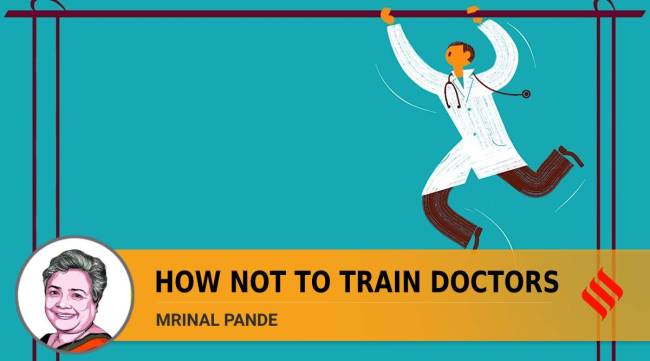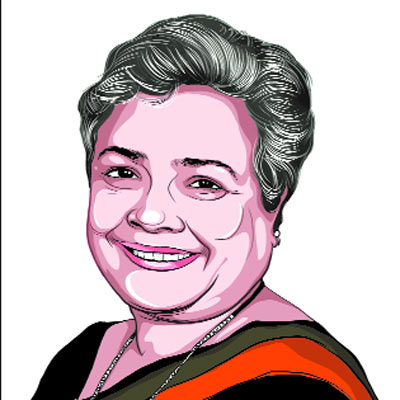Opinion How the new edict about switching the medium of instruction will make teaching more complicated
Medical translation involves understanding nuances of language and intricacies of super speciality fields. A hasty political decision could do more harm than good
 Medical education in India today faces a major challenge. We do not lack colleges — if that means buildings. (Illustration by C R Sasikumar)
Medical education in India today faces a major challenge. We do not lack colleges — if that means buildings. (Illustration by C R Sasikumar) In a democracy resting on the first-past-the-post system, an absolute majority in Parliament and/or state assemblies often creates the illusion of absolute power. So, without assembling linguists, trusted advisers and senior doctors for detailed and rational discussions or ensuring the necessary infrastructure to produce well-translated and peer-reviewed texts, the Madhya Pradesh government has announced its decision to switch the teaching medium for students of medicine, at all levels, from English to mother tongue, Hindi.
A language has been used to anaesthetise logic and surround the project with a supremacist glory for members of the Party. Applause followed and the social media wing posted comments declaring, “Out English, Out”. But like Lady Macbeth’s infamous spot, English, it appears, cannot be wished away hastily without doing major damage to the process of teaching medicine to undergraduates, postgraduates and those researching super-speciality fields.
Medical education in India today faces a major challenge. We do not lack colleges — if that means buildings.
Medical colleges have grown in number by a third in a decade. But faculties have not. Between 2013-23, according to GOI figures, the number of colleges grew by 36 per cent, and under different kinds of pressure, the undergraduate seats grew by 79 per cent and postgraduate seats by 93 per cent.
Even in the much-applauded 19 AIIMS India now has — two more are set to be set up — teaching faculties are barely above 50 per cent of their required strength. It is no surprise that the Indian Medical Association’s Junior Doctors’ Network has gone on record to say this hasty and politically-motivated decision has resulted in quality being sacrificed for quantity. There was a lack of proper planning and inadequate attention to the creation of infrastructure before the plans were operationalised. That’s why most faculties are today producing underskilled doctors.
The new edict about switching the medium of instruction will certainly make teaching more complicated for those who train the gen-next of doctors for India, given that all of them have been taught in English, conducted their research in that language and published most of their research in English journals. A point not usually noted is that not all of the most skilled and experienced professors of medicine in the Hindi belt are from the Hindi-speaking states.
In introducing such a fundamental — and sudden — change in the teaching medium for an intricate, ever-evolving science like medicine, the proponents should have kept their focus on people and not directed their energy at promoting a political ideology. This is something that could stoke an emotively charged issue.
Ah, here is a Hindiwali biting the hand that feeds her, some may say. A language, let me remind our honourable policymakers, might appear placid on the surface. But those of us who have spent a lifetime diving into them, know they hide countless eddies and currents. How aware were those who advised the government on this decision that medical texts are full of not just English but also terms from Latin, French, German, Slavic and dozens of other world languages? Let’s heed some lessons from history and not forget what happened when Fort William bhasha munshis (clerks) of the 19th century attempted to create a standardised Urdu in Persian and Hindi in Devnagari script for their British masters.
The translator’s project, unless handled with care and sensitivity for the end users, could end up opening faultlines and dividing minds not just in the medical community, but also in many other domains in the field of higher learning.
It is not as though we are not capable of producing skilled doctors. The youngsters who are selected by the prestigious med schools in India after passing gruelling entrance exams are some of the best in their batch.
But it is imperative that they be taught by the most seasoned gurus who can hone their skills and expand their understanding of global medical systems. But instead of casting the net wide and upgrading the selection criteria, improving working conditions and providing senior doctors good salaries, the government seems to be in a desperate hurry to fill vacant posts by downgrading the system.
Our national medical education regulatory body seems to be taking a reductionist approach. The minimum qualification for teaching postgraduates and super specialty courses has been diluted. The pass criterion for the theory papers has also been reduced from 50 per cent to 40 per cent. The National Medical Commission (NMC) has also relaxed the basic norms for states to establish new colleges and increase seats. It is unlikely that no one knows a lot of private medical colleges are being serviced almost entirely by ghost faculties because, despite all its drawbacks, the AIIMS jobs continue to soak up the best.
I may not be a doctor but I am the mother of one. She called me once from the OPD where she was interning in the 1990s to ask, what is a takhna? Why, it’s an ankle, I told her. Oh, I thought it was aidy. No aidy is the heel and pindli is calf. Oh lord, she sighed.
Can you imagine, dear reader, the mind-boggling problems a skilled senior professor explaining the various intricacies within the human body to post grads in Hindi is going to face when she cannot locate the correct Hindi/Hindustani term for each cell, nerve and blood vessel? Remember even the learned translators of the voluminous Hindi avatar of the new medical text, so proudly displayed in the national media, could find no better name for it than “anatomy”. What a sad and sheepish backdoor entry for a language that is being rejected.
The writer is former chairperson, Prasar Bharati






